The content of the article
The bush of a decorative rose consists of several stems covered with thorns and wide leaves of a dark green hue. Buds are white, pink, bright red and burgundy. Some varieties throw black and orange inflorescences. A room rose growing in a pot is 1.5–2 times lower than a garden one, and the diameter of its buds reaches 10–15 cm. The flower will develop well if the temperature conditions are observed, regularly water and feed the soil.
Right window
Rose refers to photophilous plants. The bush will be liked on the southeast or east windowsill. The flower receives enough light and heat even in winter. Some varieties of decorative roses prefer southern windows. To understand whether a plant is comfortable or not is simple:
- Have the leaves acquired a rich green hue and buds have blossomed? The flower feels comfortable. He has enough light and heat.
- Leaves and inflorescences become sluggish? Yellowed edges or brownish spots? Rose due to the abundance of ultraviolet radiation received a burn. The plant should be immediately hidden in the shade until complete recovery, and then choose another window sill with dim lighting.
In the summer, when there is too much sun, the pot with a decorative rose is rearranged on a shelf or stand. You can close the window blinds or translucent tulle, which will soften and scatter the sun's rays.
In late autumn and winter, the rose sunbathes under a table lamp or a special one, designed for indoor flowers and seedlings. The lighting device is turned on for 3-4 hours. The ornamental plant becomes sluggish due to lack of sun and ultraviolet radiation. Immunity decreases, and insects begin to attack the rose: spider mite, aphids and other pests.
The distance from the lamp to the top of the decorative bush is 30–35 cm. If you put the device closer, burns will appear, and if you go further, the rose will not receive the amount of light that it needs for normal development.
The flower is grown in light pots. Dark flowerpots do not fit, in the summer they attract too much ultraviolet radiation. Sunlight overdries the substrate and the roots of the decorative bushes, because of which they fade.
Brown, black, and navy blue pots are wrapped in clean sheets of paper in the summer. The white cover reflects light and prevents drying out of the soil. The roots and substrate can also be covered with A4 sheets or regularly moistened from a spray bottle.
Water and low temperatures
Roses love light but hate heat. In the room in which there is a pot with a decorative bush, high humidity is maintained. A minimum of 60–65%, but not higher than 80%. Tropical climate is also contraindicated. With an excess of moisture in the soil, a fungus appears, which leads to the death of a tender plant.
In summer, the decorative bush is sprayed with soft water at room temperature. In winter, the liquid to moisten the soil and leaves is heated to 37–39 degrees. Spraying is carried out 1-4 times a day. If the air is dry or a rose pot is near the battery, water is sprayed as often as possible. The number of sprayings is reduced if the room is cold or the substrate is too wet, and fluid is constantly accumulating in the pan.
Spray water in the evening. In the morning, moisture accumulates on the leaves and petals, attracting the sun's rays, which leave burns on the delicate plant. In the afternoon, next to the pots are placed bowls filled with water. The liquid gradually evaporates, moistening the air that the flower breathes.
Roses do not tolerate heat and frost. In the summer, in the room where the plant stands, the temperature should range from +16 to +22.In winter, the thermometer shows +12, but not lower than +8, otherwise the indoor flower will become ill and disappear.
Tip: In November or December, a decorative bush can be taken out onto a glazed balcony. And so that the soil and roots do not freeze, put the pot in a bucket or a large pan with sawdust.
Owners of roses make sure that the humidity level in the room does not fall below 40-50%. Dry air is an ideal medium for the reproduction of spider mites. Small insects destroy the root system. The decorative bush becomes weak, it is attacked by diseases and fungus.
During the period of active flowering, a rose is bathed, observing several rules:
- The procedure is carried out once a week.
- The water temperature should be + 36–38 degrees.
- The pressure is weak so as not to damage the stem and buds.
- The pot is wrapped in a dense plastic bag or garbage bag so that water does not get on the substrate.
- After bathing 3-4 hours, the rose stands in the bathroom. It is returned to the windowsill after drying.
- Wet decorative bush protect from drafts and direct sunlight.
The shower washes away dust and insects that have decided to settle on a flower. The rose receives a portion of moisture that stimulates growth. A plant that has dropped buds is not bathed. The decorative bush falls into a kind of hibernation and is gaining strength, it does not need water procedures.
Watering and fertilizer
In winter, the indoor flower is watered 1-2 times in 10 days. A plant that rests and recovers after flowering needs some fluid. In the spring, when the rose wakes up, the number of waterings is gradually increased.
In summer, the substrate is moistened almost daily. Water nourishes and cools the root system of the ornamental bush, protecting it from pests. 500-600 ml of liquid are poured into the pot and wait half an hour. In 30 minutes, the substrate absorbs as much moisture as the flower requires, excess drains into the pallet. Leftovers immediately poured. The liquid must not stagnate, otherwise it will become a source of fungus or infection.
Water from the tap is upheld for at least 3 days so that harmful minerals settle to the bottom. Impurities of iron and salt pollute the soil. It acquires a white shade and loses its nutritional properties. The rose is also watered with distilled and mineral still water. It is not necessary to defend it.
The soil is loosened before applying the liquid. The procedure allows you to determine how wet the substrate is. If the ground is wet and sticks together, watering is postponed for 2-3 days until the soil dries. Loosening also enriches the roots of the ornamental bush with oxygen, stimulating growth.
Water is always warmed to room temperature. Cold liquid, like too hot, injures the roots. Icy water does not absorb well and reduces the immunity of the plant.
Novice gardeners sometimes fill the rose. The first symptom of excess moisture is the tails. Flea-sized white insects appear only in wet soil. Pests will disappear after reduced irrigation.
Slippery soil that exudes a sour smell is thrown away. Symptoms indicate a fungus that cannot be destroyed. The pot is disinfected, the roots of the ornamental bush are cleaned from the ground and washed, and then planted in new soil. This is the only way to save the rose from infection and death.
During the growing season and active flowering, the plant is fed with complex mineral fertilizers. Ideal or another drug containing nitrogen and potassium will do. Mullein is distinguished from organic feeds. A ten percent solution is prepared from it.
The ground before fertilizer is abundantly watered. Water will moisturize the roots and protect them from burns. After 15-20 minutes, when the decorative bush absorbs liquid, a nutrient solution is added. In winter, when the rose is at rest, fertilizers are not used.
The top of old flowers, which are more than 3-4 years old, is sprayed once a month with liquid fertilizer. A weak solution is prepared and sprayed onto leaves and buds.
Transfer
A young plant that is less than 4 years old is transplanted annually into a new pot.Buy a clay pot with a drainage hole. A plastic version is also suitable, always with a pallet. The new pot should be 4–5 cm wider and 6–8 cm higher than the old pot.
A flowerpot bought in a store is washed with warm water. Sometimes a little antibacterial soap is added, but after the procedure, the container is thoroughly rinsed. Clay pots are soaked for several hours in warm water.
Old flowerpots, in which another flower lived, are cleaned of soil residues using a soap solution. Then rinse and pour over boiling water. Hot water will destroy the infection and the fungus that could remain on the walls of the pot.
The flowerpot is filled with a drainage layer consisting of grated foam, broken brick or clay shards. Fine pebbles or porcelain tiles will do. The height of the drainage layer is approximately 4 cm.
A nutrient mixture is poured into the pot, which is prepared from 3 components:
- soddy soil;
- coarse river sand;
- rotting manure.
Soil and sand are calcined or steamed. Insects and pathogens can live in land brought from a garden or orchard. Sometimes peat is added to the substrate for decorative roses.
About a liter of water is poured into an old pot with a decorative bush to soften the ground. After 20 minutes, put on tight rubber gloves and wrap a flower around the base. The flowerpot is turned over and carefully removed from an earthen coma. Sometimes the pot needs to be rolled several times around the rose, so that the substrate is separated from the clay walls.
The soil from the root system is cleaned if insects or a fungus are wound up in it. The substrate is carefully removed by hand, and then washed the base of the decorative bush with warm water. In other cases, the flower is transferred to a new pot with the old soil.
3-5 cm of soil are poured into the pot. The roots of a decorative bush are placed on a tamped earthen pillow. Straighten and fall asleep with a layer of substrate. 50-60 ml of water are poured into the soil and wait for it to settle. Then add a portion of the earth to cover the roots of the rose.
A pot with a decorative bush is cleaned in a warm room, but hidden from direct sunlight. Do not water 5-6 days. During this period, the transplanted plant survives and adapts to new conditions. The rose is returned to the windowsill in a week, and after 14-21 days, mineral top dressing is applied.
A decorative bush is replanted in early spring until the first buds appear. Sometimes the procedure is carried out in late autumn, after the last petals fall. But then top dressing is not necessary, because the rose "hibernates." Fertilizers can provoke flowering, which will weaken the indoor plant.
Pruning
In November or December, when the rose fades, pruning is performed. Thin and dry branches, as well as shoots growing not up, but inside the bush, are removed with a sharp secateurs. After each process, the blade is wiped with a cotton swab dipped in antiseptic or alcohol.
The main stems are also trimmed by about a third. The main thing is that 5-6 eyes are left on each. Wounds are sprinkled with activated carbon powder. After processing, the decorative bush is brought to the balcony or other cool place. Cropped stems can be used to grow new indoor plants.
A rose is not as capricious as an orchid, but it will wilt without proper care. A decorative bush will delight you with white and red buds, if you water it in a timely manner, fertilize and cut it. And also protect from drafts and direct sunlight, bathe and transplant annually into a larger pot.
Video: how to care for a home rose

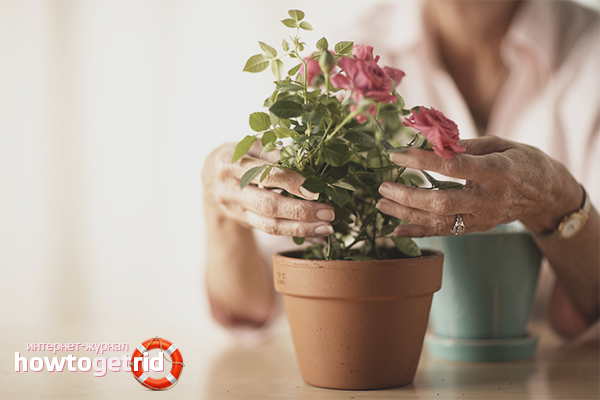
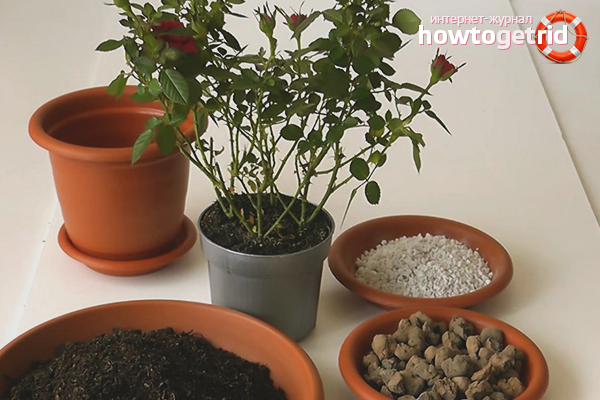
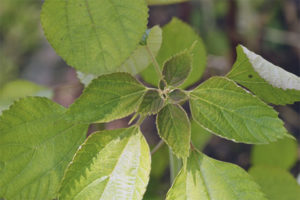


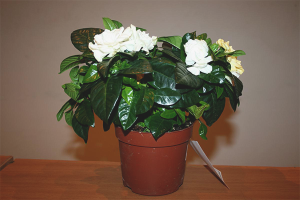
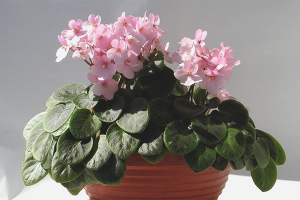



Submit